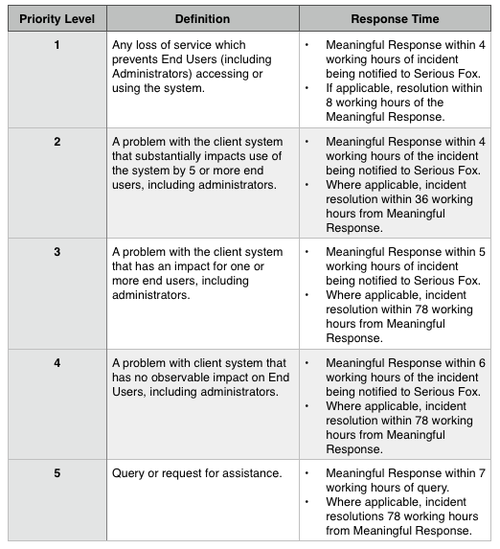One of the biggest issues that can plague a support team is the difference between what you and your client deems a ‘business critical’ bug. As touched on in my last blog post ‘client transparency - when to respond’, what a client may see as business critical may not be your definition.
Probably the most important ways to avoid this sort of confusion is to educate your client (no matter how technical they are) as to how your support team classifies bugs - including the difference between a ‘severe’ bug and a ‘priority’ one.
By having this conversation at the beginning of a support contract, you are explaining to the client what they can expect from your service. This takes out the guess-work for the client, creating transparency and an educated working environment.
To ensure our clients are on-board and understand our support hours and response times, we include these (and their definitions) within the support contract. This mitigates risk should you have an unreasonable client - by signing the support contract they are confirming they understand and agree with the terms.
But remember - this is also an agreement your company is making with the client. Do not put times within this section that you do not plan to uphold. It is a two-way contract, and good client services means delivering when you say you will.
Below is our table of response times at Serious Fox - as with all rules there are exceptions. This table does not replace human interactions with your client. It is important to ensure your client understands how to properly define bugs, which means you may need to help them the first few times. While it may be slightly time consuming in the beginning, this will save a lot of hassle later and secure good client relations.

Things to note:
- Meaningful Response’ does not mean acknowledgement of bug, but rather a response with substance (ie. explanation, bug fix estimate). This does not take place of the initial ‘We’ve received your email and are looking into it,’ which should be sent as soon as a bug is received.
- All ‘response times’ have ‘Working Hours’ after. As a company, you must remember to put working hours into your support contracts - unless you plan on being available 24/7.
As a client-facing member of the team, communication around bug definitions will be crucial to scheduling their urgency. Occasionally you may find bugs that don’t fit into the chart above. Sometimes bugs that are a priority to the client are not crucial to the operating of the system. By working together with the client to determine the impact of the bug and understanding their reasoning, you can educate them on severity while understanding their priority - then make a scheduling decision you both can be comfortable with.
In summary, ‘Communication’ and ‘Clarity’. By communicating with the client and offering a clear definition of response times before a situation arrises, you create a more controlled and less panicked-driven working relationship. And to be honest, you’ll probably keep more support contracts and clients.
Until next time,
Allison

